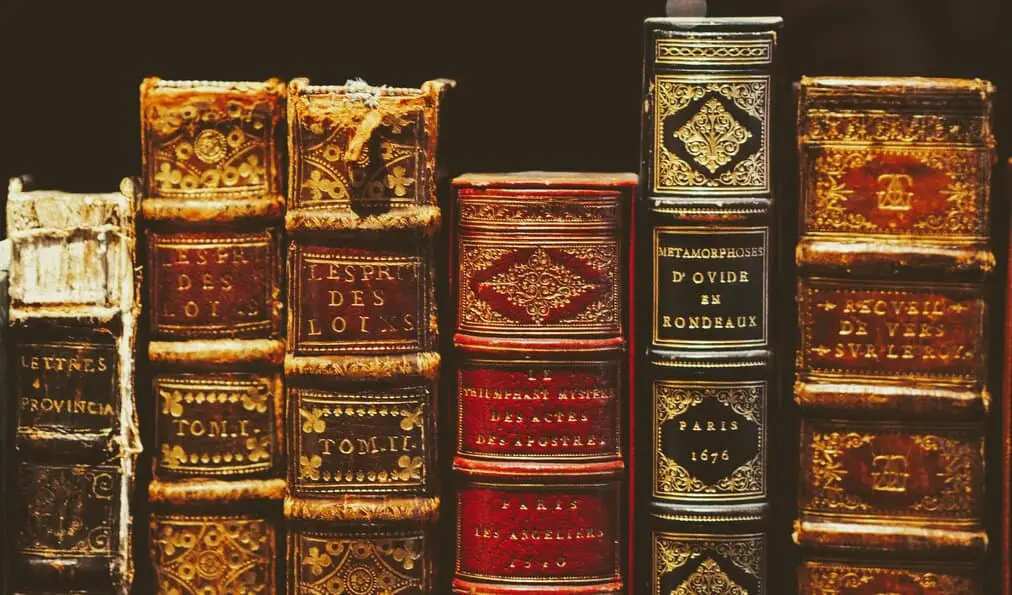Even if you’re not going to read an antique book, and there are good reasons for not, showing them off is a major part of having an impressive collection. The problem is that many common ways of stacking, shelving, or otherwise showing off books can actually cause wear or damage over the long-term, especially on the binding.
Not what anyone wants to see, especially when you have had the money and luck to find that perfect rare NF+/NF+. You just don’t want to see even the smallest degradation in appearance and/or value.
So how do you display antique books so you can show up (or simply admire) your collection without damaging these old rare books?
There are several options available and we are going to go through them all!

Store Vertically, Not Horizontally
While there are great looking images of a book sitting in a glass case open to a special page, that’s actually not a great way to display a book. This can put pressure on the binding. While for some books this can be done for short periods of time with little fear of damage, it’s not a good long-term setup and will almost certainly cause issues with the overwhelming majority of old books.
Books are designed to be stored vertically on shelves, and that is the setup that will do the least amount of damage and wear on the book itself. This is the best way to store them, though there are additional precautions and factors that should be taken to keep your rare books in the best shape possible.
Books were designed for shelves so step one is storing them vertically whenever possible. If you do have some “Show-off” pieces it is usually best to carefully rotate them, the way good wine stores rotate bottles from shelf to side storage in back every few weeks.

Custom Clamshell Boxes
Clamshell boxes are custom made to the proper size to fully envelope and protect a rare book. Since the boxes are custom made to fit, they can provide near perfect protection for each individual book. The right expert could design the outer clamshell boxes to the appearance that you wanted, perhaps even mimics of the book itself, giving full protection while maintaining the appearance of the very books being protected.
From a pure protection standpoint these can be an ideal solution although some creativity may need to be applied with the aesthetics of the design to create the best possible option for displaying valuable old books.
I personally love this option, especially when you find a specialist who can make the clamshell box appear like the book itself. This gives full protection to your antique books while also showing off your collection in a way you can appreciate. Aesthetics + Protection; it’s the perfect combination for many smaller collections!
Metal Shelves Vs. Wood Shelves
This one can hurt. There are few things more beautiful than old rare books standing regally side by side on a mahogany wood book shelf. The trouble? Wood shelves can have oils or acids that over enough time with direct contact can result in damage because of how they interact with the paper.
This is the same reason that plastic sheets for baseball cards recommend only one card per sleeve instead of doubling up.
Metal shelves are safer, though if you’re in the large group who much prefer the look of wood shelves, I can’t blame you. I grew up with twin Mahogany book shelves in the living room that looked gorgeous and held a complete Encyclopedia Britannica, photo albums, and some of the proudest mementos of the family passed down over the decades.
Wood shelves look stunningly beautiful and given the choice I would take them over metal shelves every single time.

However, you will want to look at ways to have protective lamination, glass or acrylic covering, or faux wood if the books are coming into direct contact with the wood itself because over time the acids from wood, and many wood treatments, can interact on a molecular level with the dust covers, cloth or leather book covers, and actual pages of the antique books.
And that means over a long enough timeline damage, even if very minor, will begin to occur.
Not good. Not good at all.
That heartbreaking news has people looking at metal shelves, but let’s also be real: aesthetics matter.
And seeing beautiful first edition first printing books lined up on cold gray or black metal just feels wrong. Aesthetic has to matter.
So while metal book shelves are the practical, engineering answer over wood, for many of us other options are going to have to come into play to get a satisfactory resolution to this problem.
Because my collection of Steinbecks, Hemingways, and Sinclair Lewis first editions are not sitting on an open metal shelf in a room surrounded by fine wood furniture and cases.
Book Display Cases
There are specialty book display cases that can be designed specifically with delicate, antique, or valuable books in mind.
Many of these are faux wood or use the original rich mahogany (or other wood of your choice but honestly – how do you beat a truly beautiful piece of old mahogany?) but with a proper protective coating that will not negatively interact with the collectible books on the shelves.
These are custom jobs that change depending on the type of books being displayed, the average size of the book, and the overall goals of the display.
Are these shelves upon shelves of books standing vertically next to each other, filling out entire rows, or a few very high value antique books that are meant to stand out, be easy to spot, and each taking up their own space?
These can result in drastically different designs for those book display cases depending on how you want everything to look or how the main center of attention should be focused.
This can be a more expensive option depending on how customized you wish to go with it, but it allows you to create a display setup specific to what you are looking to store, show-off, or appreciate.
What about Open Book Displays?
While these are undeniably cool looking, they aren’t the best long-term solution. Open books can cause damage, especially to the spine and binding. There are libraries that rotate certain works, but in most cases best practices do not encourage open book displays for your antique books.
Depending on the book or work, it could be that the open page goes to where the use of the binding is already set, and at that point for an old enough work that’s not meant to be moved or handled that keeping it to that spot is less damaging than risking exposure to dust, sunlight, air, or other potential damaging agents.
The type of bookbinding can also affect the viability of this as an option, so with specific books it’s important to always consult with a specialist who will be able to look at the specific work (or works) and advise based on age, materials, condition, bookbinding method used, and any other mitigating factors that can make a difference with how displaying it could work.
What about Protective Cases for Rare Book Displays?
These can offer some degree of protection, especially from things like dust. Depending on the type and style of books, having glass or clear acrylic cases can help make sure air and dust don’t wear down the books over time.
When you have antique books for display, finding the ideal protective case is crucial to protect your collection in addition to creating the type of display you want to be able to show off.
I like the idea of protective cases and for certain books or collections they make sense. Especially if you are never going to be thumbing through the books or handling them as little as possible.
On the other side of things, sometimes you like to hold the books, smell that unique smell that only comes from aged pages, appreciate holding history in your hands. I wouldn’t do this with a leather bound manuscript from 1650. But for a first edition of The Old Man and the Sea or The Grapes of Wrath, I might.
Protective cases are going to be a solid solution for a certain type of book, but they are what you would call a premium solution, which is sales talk for expensive.

Watch the Light
One of my favorite Florence & the Machine Songs has the line “No light, no light,” and that is not only a catchy rock tune but it’s also great advice for protecting yo books. Sunlight can damage books with enough time and exposure.
Damage can include fading of color, and with enough exposure over enough time that can result in massive damage whether we’re talking about dust jackets, the coloration on the actual book, or even leather bindings. Sunlight is great for a lot of things, but it is no friend to your antique books.
Wherever you choose to display your rare or antique books, make sure they are removed from direct sunlight. Artificial light is fine, but you don’t want direct sunlight coming in on the books as that will definitely cause fading and damage over time.
Keep your collection out of the sunlight to preserve it.
So What Is the Best Way to Display Old Books?
Honestly, all of these options are excellent, but some are going to work better than others. It’s also worth noting that the exact type of antique books that you display and collect make a difference.
For example, if you are a major fan of early 20th century literature as you collect first edition Sinclair Lewis, Ernest Hemingway, William Faulkner, John Steinbeck, and other books in a similar vein you might decide the best way to put these antique books on display is a protective plastic cover over the dust jacket and then have all books side by side on the shelves.
This is a fair bit of protection. On the other hand if you’re looking for information on how to display a rare book that is leather binding, from several centuries prior, just sliding it onto the book shelf is not the likely best solution.
However, it’s better than stacking them on their sides or in the sunlight. When you are trying to figure out how to display a rare book look at your options, consider the value of the book, and when in doubt talk to your nearest antique book dealer for professional advice on the best way to display your antique books without damaging them.

Displaying Valuable Collectible Books: The Conclusion
There are multiple options for displaying antique books and the style and type of book can make a major difference when you are making that decision on which route to go. While I admire the Czech Library option of having the truly special old books sitting under a display case in a well lit vaulted room with book shelves full of old leather bound books, most of us don’t have the building, the funds, the library to pull something like that off.
That doesn’t mean that our most prized collectible books need to sit hidden on a shelf in plastic dust cover shields being the only indicator of anything worth looking at, and only to the few with a discerning eye.
There are plenty of options when it comes to displaying a rare book collection, and the specific type, value, and style of collectible books in the collection can make a huge difference when it comes to finding the right option for an excellent display.
Do your homework, keep the health and quality of the book in mind first and foremost, and consult with professionals to see what viable options are in the area and you will end up with a solution that should work out beautifully to balance care, safety, and aesthetics.
